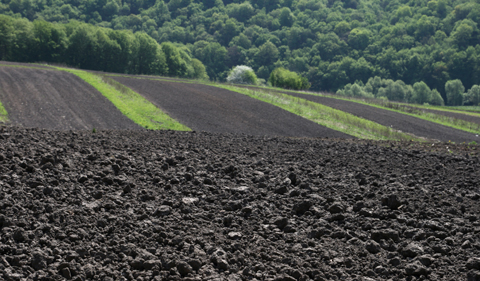Above the soil, trees and crops are dining on carbon dioxide—even grabbing more than scientists originally expected from the atmosphere. They might suck some of that carbon into their roots, or lay it down upon the soil as they wither with winter.
While one Ohio University researcher is studying how much carbon farmland and forests absorb from the atmosphere, another is looking at what happens to carbon in the soil—with implications for the climate change conversation.
Will the blanket of earth on the planet continue to hold more carbon? Or might the soil eventually belch more CO2 back into the atmosphere if its digestive enzymes get out of balance?
“In the last decade, a growing concern about the potential consequences of climate change on soil processes, coupled with a desire to develop methods of improving carbon sequestration, have stimulated experimental research, modelling and theorizing,” writes Dr. Jared DeForest in “Soil enzymes in a changing environment: Current knowledge and future directions.” DeForest is Associate Professor of Environmental and Plant Biology at Ohio University.
His co-authored article won the 2013 John S. Waid Review Award and is now freely available online.
DeForest has set the table for how researchers might look at decomposition in the soil and even how they might manipulate its appetite for digestion. His dinner companions might be a diverse group—mathematicians, aquatic specialists, genetic bioengineers, even nanotechnology developers.
The Main Actors—Enzymes
The recycling of carbon-rich plant material in the soil depends on “an aggressive consortia of microorganisms.” The agents of organic matter decomposition are extracellular enzymes (EEs for short).
The food web depends on the depolymerisation (breakdown) of the carbon and nitrogen components of plants, microbes and animals and the production of minerals in the soil. This creates “the trophic base for detritus food webs, drives global carbon and nutrient cycles, and mediates plant production and atmospheric composition,” says DeForest.
Increased soil temperatures, elevated atmospheric carbon dioxide, and more frequent wetting and drying cycles will affect how the microorganisms do their job of dealing with litter decomposition and root exudation (think sap). “Soil organic matter is an often recalcitrant complex that is both synthesized and degraded by microbial enzyme activities. The balance between these two competing processes determines how much carbon is sequestered,” DeForest says.
“Those attempting to quantify or even manipulate the outcomes of global warming must now take into account the microbial responses, including soil enzyme activities, that may affect recalcitrant humic matter.”
Adding or Subtracting Carbon?
Researchers need to find out more about how microbes in the soil regulate enzymes in order to be able to predict how changes in temperature and rainfall might disrupt the breakdown of carbon into the soil.
Think of pools of tiny cells foraging in the soil for “food” (substrate). How much energy does it take to find it? How much energy goes to producing the enzymes needed for decomposition? And how much goes to other cell functions?
What happens when soil temperatures rise? The rate of enzyme activity may increase with temperature, but microbes may decrease enzyme production in response to warming. Similarly, during drought, enzyme production might go down even as the size of the microbial pool grows.
“We urgently need more information on microbial regulation of enzyme synthesis, secretion and survival in order to predict how enzyme pool sizes, stability and activities are likely to change with changes in temperature and precipitation frequency,” DeForest says.
“There is increasing evidence that root exudation rates will increase with elevated atmospheric CO2, altering the relative availabilities of soil carbon and nutrients, particularly nitrogen, in soils,” DeForest says. “This has the potential to modify heterotrophic soil respiration which, in turn, may further increase atmospheric CO2 concentrations. However, we need more detail as to how microbial enzyme production and turnover are altered by changes in root exudation and plant litter deposition in order to be able to predict changes in the net ecosystem exchange of CO2.”
Managing the Soil?
“Given what we know about extracellular enzymes, from the molecular processes of their generation and how their externalization is controlled to their locations and activities in the environment, the question arises: Do we have enough information to manipulate activities in order to promote specific ecosystem services?” DeForest asks. “The answer to this depends on our level of understanding regarding the particular enzyme(s) involved and the large number of abiotic and biotic factors affecting activity.”
“For example, should we manage environments to promote the abundance, gene expression and/or protein assembly by organisms that generate the desired enzyme(s) or should we attempt to create optimal conditions for the activity of extracellular enzymes functioning broadly independently of cells?”
Biostimulation, for example, might include adding nutrients or promoting fungal growth by reducing tilling. Bioaugmentation might include culturing bacterial strains in order to harvest the enzymes that need to be added to the soil. Another option might be to engineer plants as vectors to distribute the needed enzymes.
Researchers, DeForest notes, have much to explore.
Will the future include nanoscale probes for real-time measurements? Can researchers develop a soil enzyme index that can be used as a reliable measure of soil fertility and health? Can soil enzyme activities be manipulated to achieve effective generation of plant nutrients, control pathogens and pests, and clean up and regenerate degraded and polluted environments?
Read more of DeForest’s thought-provoking questions—and the nine key research priorities he identifies in his article.





















Comments